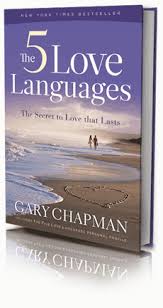I’ve heard of the classic struggle between straight couples: she wants to talk, to spend time together, to communicate. And he tends to do things, like gas up the car, mow the lawn or manage the family finances. Both fail to understand why they don’t feel loved or why their tokens of love aren’t fully received by the other partner.
Not every couple who complains has this particular dichotomy, but several who have bent my ear do and a few have mentioned one eye-opening book in particular. Gary Chapman’s The 5 Love Languages: The Secret to Love That Lasts intrigued me because I could easily identify two love languages, or so I thought. I wanted to know what the other three were as well.
Chapman has spent his career counseling couples. The 5 Love Languages is a swift read and rings true. It’s one of those books that makes the implicit explicit, almost seeming like too-easy common sense until one starts to think about the day-to-day application. While the book affirmed much of what I know of love and communication, it also presented several aha! moments which I appreciated.
 The five love languages include:
The five love languages include:
- Words of Affirmation
- Quality Time
- Receiving Gifts
- Acts of Service
- Physical Touch
Before reading the book, I blurred several of these together. Chapman breaks them down, clarifies what they are and offers concrete examples from real couples he has counseled. He also offers exercises and questions at the end of each chapter.
In the scenario I mentioned above, the primary love language of the female partner might be Quality Time. That’s what she’s expressing a need for, although her partner isn’t speaking it back to her. Instead, he’s speaking Acts of Service and might need one of the other love languages himself.
Chapman provides short surveys to discover what your primary love language is, but the real key is to just think about what you really want from your partner. Specifically, what are you always asking or, maybe even nagging, him or her about?
If you really wish your partner would hold your hand more often, your language might be Physical Touch. If the simplest gifts can send you over the moon, Receiving Gifts might be the trick to filling your love tank.
The genius of this book is that it casts love as a language. Think of it this way, if you met someone who spoke Portuguese and fell madly in love with her, wouldn’t you want to begin learning the language? And wouldn’t it mean an enormous amount if s/he attempted your first language?
It’s the same with love. If you knew it meant more to your partner to hold her hand than to fill her car’s gas tank, why would you keep filling the gas tank while neglecting to hold her hand? That’s actually a loss on the scoreboard of love: it does nothing for you and doesn’t mean much to her. But, if Acts of Service was her primary love language, wouldn’t you want to step up and do the dishes/fold the laundry/get the kids ready rather than ask her to sit down and talk to you while she has all those chores on her mind?
Personally, this book gave me a sense of relief around a past relationship. In that connection, my primary love language, Quality Time, was spoken: given and reciprocated with richness. However, the relationship was pretty negative otherwise and I should have disconnected much earlier than I did. I’ve carried some heaviness for not doing so.
But now it makes sense: my primary love language was spoken loudly and clearly, so I was able to put up with much more than I should have.
In my current primary relationship, it seems we both speak Quality Time. After that, I speak (need) Words of Affirmation, although Gifts, if they’re connected to Acts of Service or Quality Time, can really floor me.
What I really appreciate about The 5 Love Languages is that many couples – and couples counselors – tend to encourage verbal communication, which is only 1/5 of the set of possibilities (Quality Time). If your partner doesn’t speak that language, no amount of talking or counseling will help. So I appreciate that Chapman gives full and equal credit to the other types of languages – and humans – out there! This should provide relief to the couples hitting a brick wall in the communication department.
Given the list of 5 languages, does one strike you more strongly than the others? And what do you think your partners might be? Buy a copy of the book, pass it along, and see what languages are spoken in your household.